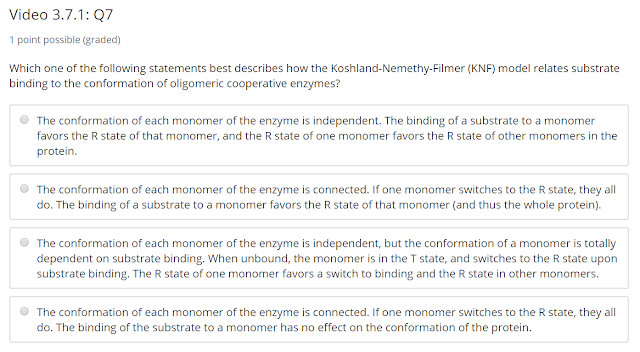CTP inhibits ATCase activity
When dissociated into subunits, one of them did not have catalytic activity, and bound CTP.
Homotropic refers to using the same substrate to regulate.
Allosteric refers to using different sites to regulate.
So we have
The binding of a substrate to one subunit promotes the transition to the R state in the other subunits of the enzyme.
We want to heterotropic, so it is not the second choice.
It is allosteric, so it is not the active site, not the first choice
We want activation, so we want R state.
Therefore the answer should be the 4th choice.
A small molecule binds the enzyme at a site other than the active site, stablizing the R state of the enzyme.
CTP is the ultimate product of the metabolic pathway that begins with ATCase. When CTP is in sufficient quantity, it blocks its own production at a very early step.
T is tight, R is relax, therefore the answer is:
The R state has a high affinity for the enzyme substrates; the T state does not.
The lecture spent some time talking about these MWC and KNF models, but I am not sure how much I understood it because we never applied these models to do prediction in the lecture or exercises. Here are just the memorized answer for the two coming questions.
The conformation of each monomer of the enzyme is connected. If one monomer switches to the R state, they all do. The binding of a substrate to a monomer favors the R state of that monomer (and thus the whole protein).
The conformation of each monomer of the enzyme is independent, but the conformation of a monomer is totally dependent of substrate binding. When unbound, the monomer is in the T state, and switches to the R state upon substrate binding. The R state of one monomer favors a switch to binding and the R state in the other monomers.







No comments:
Post a Comment